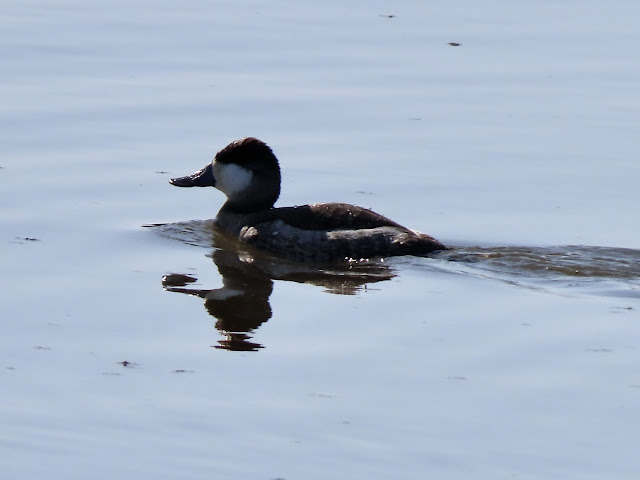Sunday, January 23, 2022
For birders in Phoenix's East Valley to visit some of the great sites in the West Valley, the favored time to do that is on a weekend day to avoid the creep of commuter traffic. We chose a Sunday when the driving was stress-free.
At 9 a.m., five of us ambled out into the sandy salt-bush fields at Birding Hotspot, Thrasher Corner. It was really really quiet. Having been greeted by a few WHITE-CROWNED SPARROW, we expected more birds to be popping up here and there. Having walked out farther than usual, I finally heard one of our target birds, the uncommon LECONTE'S THRASHER. Other birders found it on a top limb of a very distant tree. Walking forward, I started taking photos while still far back to avoid missing a shot altogether. But the bird was relatively calm with our approach to about 50 feet. A very plain-looking 10" bird with a strongly curved bill, its song almost always leads me to it. We ended up seeing two of these very pale, slender thrashers.
Birders working on Life Lists sometimes come from Europe and other distant countries to be able to see this species. Among us, it was a LIFER for both Judy and Karen.
Still on our target list for today were the CRISSAL THRASHER, SAGEBRUSH and BELL'S SPARROW.
Walking back and forth over the wide expanse of bush, we found WESTERN MEADOWLARK, BLACK-TAILED GNATCATCHER, ANNA'S HUMMINGBIRD, and one (1) SAGEBRUSH SPARROW. I caught a photo of the sparrow, very plain for blending into the desert sand and brush.
LOGGERHEAD SHRIKE tended to perch on the tippy top of different trees. It, too, was singing its short squeaky song.

After seeing NORTHERN HARRIER and COOPER'S HAWK fly over the field, we finally found a singing CRISSAL THRASHER, our final species at Thrasher Corner. It, too, is uncommon and wears grayish-brown-colored feathers. Note its white iris and very long tail. Its under-tail coverts (feathers beneath where the tail begins) are dark rufous. Judy and Karen's second LIFER for the morning!
Instead of heading home on I-10 immediately, we took a little tour of the agricultural fields in Arlington and/or Buckeye.
Our first stop was LOWER RIVER ROAD PONDS. Thanks to Glenda's scope, we were able to discern the floating white feathers as two (2) SNOW GOOSE.
Flying over the pond during our visit were NORTHERN ROUGH-WINGED SWALLOW.
Lots of other species were hanging out at and on the water: 1 WHITE-FACED IBIS flew in and perched on a mud bank across the pond; a couple GREAT EGRET; lots of NORTHERN SHOVELER, some doing their close-circle fishing. Looking into the sun was no help, but we logged in at least one (1) GADWALL; 1 MALLARD; 12 AMERICAN COOT; and 75 RUDDY DUCK.
Rounding out our visit with a stop at the Buckeye Canal & 309th Avenue ponds/fields, we added more NORTHERN SHOVELER (98), BLACK-NECKED STILT (6), and LEAST SANDPIPER (27).

We felt it was a superbly successful day. Sunny, clear blue sky day with calm wind. Can't beat that.
As usual, the link to our reports submitted to eBird is below.
View this checklist online at https://ebird.org/checklist/S101286953
View this checklist online at https://ebird.org/checklist/S101293353
View this checklist online at https://ebird.org/checklist/S101297310
* * *















No comments:
Post a Comment